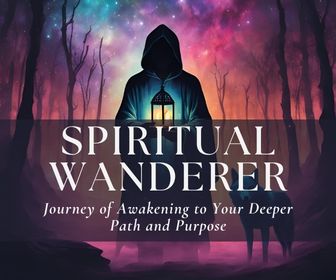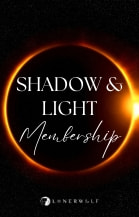Mantras are like lotus flowers that spring from the murky depths of our minds, and blossom into the purity of being.
For thousands of years all throughout the planet, mantras have been used to quiet the mind, experience inner stillness, promote the development of virtues like empathy, and experience “God.”
Mantras, although simple words and sounds repeated over and over again, are immensely powerful in their ability to raise our consciousness. Not only are words and sounds a manifestation of energy vibrating at different frequencies, but they are also imbued with centuries of meaning. In fact, mantras and chants are so ancient that they are said to be over 3,000 years (or more) old.

Spiritual Wanderer Course:
⭐️⭐️⭐️⭐️⭐ "I started the Spiritual Wanderers Course a short while ago and for the first time in twelve years I have started to experience love, acceptance and compassion for myself and within myself. Thank you so much." – Vivienne S.
If you would like to welcome the mystical influence and healing power of meditation mantras into your life, please take some time to consider what you need the most in your life right now. Do you need more love and empathy? Or perhaps you need to invite self-acceptance and forgiveness into your life.
8 Transformational Meditation Mantras
We all have different desires, needs and preferences, which is why it is so important to pick a mantra that personally appeals to you (and not just because it is popular or well-known). Remember to pay attention to each of the following meditation mantras and their underlying meanings. Choose one that appeals to you on a deep level, and one that you desire to have steeped in your unconscious mind.
My personal favorite is “om mani padme hum,” not only because it is easy to remember, but because its meaning resonates deeply with my needs in this period of my life.
I also recommend experimenting with different meditation mantras. Don’t feel pressured to choose a mantra from a different language (i.e. Sanskrit) unless you really resonate with it. In fact, you might prefer to create your own mantra which might be far more powerful than any pre-written one. You will find a few examples below.
1. OM
“Om” is said to be the first sound, and the birth of all other sounds. It is essentially the sound of infinity and is said to vibrate at the pitch of the universe (432 Hertz). This ancient sound can be chanted by itself to help focus, clear and purify the mind, or placed in front of other meditation mantras.
2. Om mani padme hum
This mantra is used by Tibetan Buddhists to invoke Chenrezig, the Bodhisattva embodiment of compassion. Literally, this chant translates to “Hail the jewel in the lotus” but it has also been interpreted in the following way:
Om – This sound purifies pride
Ma – Purifies jealousy and the need for stimulation
Ni – Purifies passion and desire
Pad – Purifies ignorance and prejudice
Me – Purifies possessiveness
Hum – Purifies hatred
This mantra is said to contain all of Buddhism’s principles in a summarized form.
3. Lokah Samastah Sukhino Bhavantu
This Hindu prayer essentially translates to, “May all beings be happy. May all my thoughts, words and actions contribute in some way to the happiness of all beings.” This mantra helps us to become aware of our irrevocable connection with all of life, and helps us to open our hearts to understanding, love and compassion for others.
4. Elohim / Hamsa / Satnam / Tao / Shiva / Ram
Chanting the name of God/Consciousness/Source/Tao is also another powerful type of meditation mantra. Select any name that appeals to you the most and sit with it in silence. Repeat the name in your mind, or out loud. Let the syllables vibrate through you and infuse your mind, heart and soul with meaning, power and significance.
5. Hare Krishna Hare Krishna, Krishna Krishna Hare Hare, Hare Rama Hare Rama, Rama Rama, Hare Hare
This mantra, popularized by the Hare Krishna movement (ISKCON), is a form of transcendental vibration that is said to expand our consciousness by repeating the three names of Supreme Being; Hare, Krishna and Rama. When repeatedly chanted, this mantra helps us to taste something known as Krishna Consciousness (purity of being).
6. Ho’oponopono
This ancient Hawaiian word translates to, “I’m sorry. Please forgive me. Thank you. I love you.” It is pronounced in the following way: ho-oh-pono-pono. This is an excellent mantra to use when you feel distressed, angry or ashamed. You might like to repeat the word “Ho’oponopono” or its literal translation, “I’m sorry. Please forgive me. Thank you. I love you” as a mantra.
Would you like to save this?
Your information will never be shared.
7. Ham-Sa
Ham and Sa in Sanskrit translate to “I am that,” and thus reaffirms our conscious presence and infinite state of undivided Being. Do this mantra by breathing in and saying “ham” (thus affirming your “I am-ness”) and breathing out saying “sa” (thus bridging the gap between self and other, creating oneness).
8. Create your own sacred meditation mantras.
There is no rule that states you must use a word or idea from another language. Why not use a word or concept from English, Spanish, Indonesian, or whatever native language you have? Here are some tips:
- Make the mantra short and sweet (no more than 10-15 words).
- Choose a word that is of great significance to you, or a sentence of deep meaning, e.g. “I am love, you are love,” “I forgive myself,” “Freedom, peace, resolve,” “I change my thoughts, I change my world” etc.
- Ensure that the mantra is framed in the positive (which the unconscious mind can process) rather than the negative (which it can’t). For example, instead of saying “I am not angry,” say “I am calm and accepting.” Or instead of “I’ve overcome my fear” say “I am courageous.”
- Repeat whatever mantra you have chosen or created for yourself many times over. Many people give up after 20 repeats expecting a miraculous change to suddenly materialize. No, mantras must be repeated thousands of times, even hundreds of thousands of times for their effects to be felt. But start slow. For example, dedicate 30 minutes every day to your mantra.
What does your mystical mantra sound like?
What sacred meditation mantras do you love to incorporate into your day? Or if you don’t have one yet, which of the above mantras do you plan to use? If you are open to sharing, please comment below.
If you need more help, we offer 3 powerful ways to guide you on your inner journey:
1. The Spiritual Wanderer Course: Feeling lost or uncertain about your path and purpose in life? Gain clarity and focus by learning about the five archetypes of awakening within you. Discover your deeper path and purpose using our in-depth psychospiritual map. Includes 3+ hours of audio-visual content, workbooks, meditations, and a premium test.
2. Shadow & Light Membership: Seeking ongoing support for your spiritual journey? Receive weekly intuitive guidance and learn to embrace your whole self, including your shadow side. Deepen your self-love and receive personal support from us.
3. Spiritual Awakening Bundle: Ready to soul search and dive deep? Access our complete "essentials" collection of beloved journals and eBooks. Includes five enlightening eBooks and seven guided journals, plus two special bonuses to further illuminate your path.









Dear Ms.Luna, how does one determine the potency of a sound in hertz?Is there any android app as well? I have not browsed your mission yet and stumbled upon this page accidentally.With Regards,
on mani padme hum. My grandmother taught us this phrase. I never changed it in real life. But surprisingly, whenever I have dreams that involves spirits, ghost, or something possessed bothering me, I wud automatically chant this. Sometime I wud realized myself in the dream I was chanting it wrong because i never knew the spelling of it but only how it sounded and that is the only phrase I know of. Chanted it in the dreams hoping the spirits n all wud leave me alone. I wonder why this happened? Coz most of my dreams r like that
Actually I learned a Mantra for Ghosts and Evil spirits just today – what a mind blower to find someone who’s written about this. I am familar with Om Mani.., but the exorcist/casting out of evil spirits is “Aing Kreem Kreem Khim Khim Khichi Khichi Bhootnathay Khim Khim Phat”
Namaste
Hare Krishna!
While all of these are very good mantras, I’m concerned about the fact that you translate them incorrectly. For example, “Ho’oponopono” does not literally translate to “I’m sorry. Please forgive me. Thank you. I love you.” That is how one practices Ho’oponopono. The literal translation of the word is “to put to rights; to put in order or shape, correct, revise, adjust, amend, regulate, arrange, rectify, tidy up, make orderly or neat.” Furthermore, your explanation of “Om mani padme hum” as an “interpretation” is questionable, for that is what each of the syllables *represents*, which is far different from *interpretation* — one is a deep meaning, the other is a superficial understanding. I also wish that you had expanded upon the meaning of the phrase “The jewel is in the lotus” rather than skipping right past it, as I find the phrase especially powerful. Overall, I’m disappointed in this article because when I first came to read it I got excited that I had discovered another site to explore, but now that I know that I can’t fully trust what you write, I’ll have to pass. When an author can’t adequately explain things I already know, I can’t trust them to adequately teach me new things. :(
estoy afuera Y él estado esperando el sol– i am outside and i’ve been waiting for the sun
Nice!
Om namha shivaye …… I think it is best.
Thank you for sharing Saurabh :)
Mera bharat mahaan….
I know one from Kejawen (ancient sacred Javanese spirituality) called kalachakra. It consists of eight pairs of words. Ancient Javanese believe that the mantra can help to increase one’s soulful energy and banish all negative energy
Wow, I haven’t heard of that mantra before. Thank you for sharing Ika! I’m now going to look into “kalachakra” …
Well, you will find it under Buddhism, but actually there’s a Javanese version of it, under Kejawen. Kejawen has many influences from other spiritual beliefs, including Buddhism. It can adopt and synthesis monotheistic religions too. So it is always expanding, without leaving its own principles
I have a question about ho’oponopono. If you’re saying this to deal with anger or troubles in a relationship of some sort how do you get past the feeling that the “I love you” is not true? If I’m saying it I can’t seem to get past the feeling that I’m lying, because at that moment I’m not loving that person, but I am wanting to forgive and let go of anger. Sometimes I also start thinking things like, “you’re the one who did/said this mean action towards me so why am I asking forgiveness?” Am I overthinking it? There is something I love about the sound of the mantra, but have that one question that comes up when these moments arise which trigger lifelong wounds.
Hi Mary. There is no rule saying that you have to “love” the person. If you don’t you don’t, and there is no point forcing it. So feel free to cut out bits that don’t feel true to you and replace them with other words. This isn’t about being right after all, it’s about healing yourself primarily.
I realize this is months ago but I have an answer to this. I live in Hawaii and was taught Ho’oponopono. In a nut shell the ancient Hawaiians maintained peace within the villages by practicing Ho’oponopono. When there was conflict the parties involved would go to the elders. Everyone is helped to see their role in the conflict and when the air is cleared all agree to let it be and never speak of it again. This part was so important that if it was spoken of again by an involved party that person was sent away from the village to live in a village made up of only those who have broken Ho’oponopono. When you see it this way this mantra has more to do with letting things go, accepting your role in it and forgiving all who involved including yourself. Most importantly, never feeding the situation by never bringing it up again. Aloha means hello, goodbye, I love you. When thinking or saying “I love you” in this mantra it could mean “goodbye with respect” which is a form of love. Hope this helps you. Aloha
Sorry I’m not trying to be a pest, but I have a different answer for you than Miss Luna. You are never saying the 4 phrases to anyone but your subconscious, your inner child. Everything you see outside of you ONLY exists inside of you. Remember the old saying whenever you find a problem you are always there? A modern “purpose” for cleaning is to reach Zero State. In this state Divinity can come into your consciousness and heal, uplift, transform, inspire, etc. When you clean something within you, you clean it within all of us.
Peace
The Modern Version of Ho’oponopono (4 phrases) practice is sometimes explained like this “I am sorry for any harm I have done. Please forgive my mistakes. I love you (all of creation including yourself, esp yourself) Thank you for the opportunity to “heal”, “amend”, “make things right” “to clean”. I’ve met “professional cleaners” I don’t know exactly what they are doing but I’ve heard their stories and seen their intensity. Interesting to think there are people who are paid to clean out there and I’m speaking of Corporate American and Multi-National Corporations, even the government.
Aloha
Gayatri Mantra.